test pilot
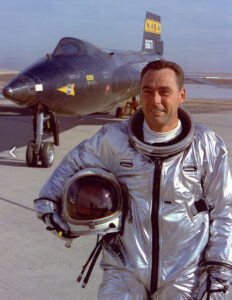
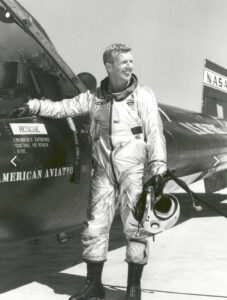 The first official space flight occurred on April 12, 1961, when Soviet astronaut Yuri Alekseyevich Gagarin, a Soviet pilot and cosmonaut who, aboard the first successful crewed spaceflight, became the first human to journey into outer space. Traveling on Vostok 1, Gagarin completed one orbit of Earth on 12 April 1961. While that was the first official manned space flight, there were other times that man touched space.
The first official space flight occurred on April 12, 1961, when Soviet astronaut Yuri Alekseyevich Gagarin, a Soviet pilot and cosmonaut who, aboard the first successful crewed spaceflight, became the first human to journey into outer space. Traveling on Vostok 1, Gagarin completed one orbit of Earth on 12 April 1961. While that was the first official manned space flight, there were other times that man touched space.
The North American X-15 was an experimental US single seat rocket powered airplane that was taken aloft by a B-52 bomber acting as its “mother ship” and released to test extremely high speed and extremely high-altitude flight. The first such flight took place on June 8, 1959.
The hypersonic rocket-powered aircraft known as the North American X-15, was operated by the United States Air Force and the National Aeronautics and Space Administration as part of the X-plane series of experimental aircraft. While it didn’t exactly go into space, the X-15 set speed and altitude records in the 1960s, reaching the edge of outer space and returning with valuable data used in aircraft and spacecraft design, making it a precursor to the spacecraft of today. The X-15’s highest speed, 4,520 miles per hour , was achieved on October 3, 1967, when William J Knight flew at Mach 6.7 at an altitude of 102,100 feet or 19.34 miles. This set the official world record for the highest speed ever recorded by a crewed, powered aircraft, and it remains unbroken to this day.
While pilot, William Knight flew an all-time record speed of Mach 6.7 (4520 miles per hour), the fastest speed flown by a powered and manned piloted aircraft, in 1967, his flight wasn’t the first record setting flight in the X-15. This incredible speed was not even close to the maximum potential of the X-15. A typical commercial passenger jet flies at a speed of about 460 – 575 miles per hour, when cruising at about 36,000 feet, which figures to about 75-85% of the speed of sound. I can’t imagine going any faster than that, much less wrap my head around more than 4520 miles per hour!!
In 1963, pilot Joe Walker flew his X-15 into the history books by flying it to a record altitude of 67 miles and achieving a speed of almost Mach 5 (3794 miles per hour). While there is no sharp physical boundary that marks the end of atmosphere and the beginning of space, it is generally marked at the Karman line, and for purposes of space flight defined as an altitude of 60 miles, although some place the line at 50 miles above Earth’s mean sea level.
The X-15 program continued until 1968, when the rocket planes were retired. On notable pilot was Neil Armstrong, who was also the first man to walk on the Moon, of course. Armstrong made 7 flights in the speedy rocket plane. Also interesting to note is the fact that during the X-15 program, 12 pilots flew a combined 199 flights. Of the 12 pilots, 8 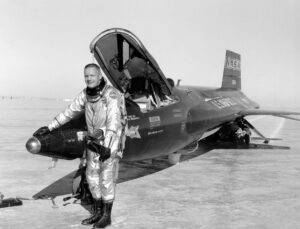
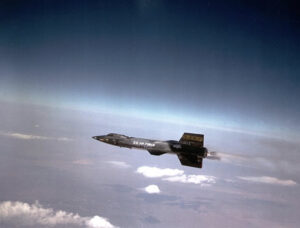 pilots flew a combined 13 flights that exceeded the altitude of 50 miles, thus qualifying these pilots as being astronauts!! Of those 13 flights, two (flown by the same civilian pilot) met the FAI (Féderátion Aéronautique Internationale) definition of 62 miles of outer space. The 5 Air Force pilots qualified for military astronaut wings immediately, while the 3 civilian pilots were eventually awarded NASA astronaut wings in 2005, 35 years after the last X-15 flight.
pilots flew a combined 13 flights that exceeded the altitude of 50 miles, thus qualifying these pilots as being astronauts!! Of those 13 flights, two (flown by the same civilian pilot) met the FAI (Féderátion Aéronautique Internationale) definition of 62 miles of outer space. The 5 Air Force pilots qualified for military astronaut wings immediately, while the 3 civilian pilots were eventually awarded NASA astronaut wings in 2005, 35 years after the last X-15 flight.
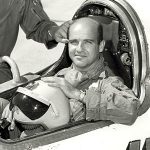 For years after the first planes began to fly, aviators knew that they would eventually go faster and faster. I’m not sure who first came up with the idea of flight at Mach speed, but it was a challenge that the test pilots quickly set their sights on. Test pilots are a notoriously reckless bunch. They know that the planes and speeds they test could get them killed, but they do it anyway, trying to beat the odds. The first Mach 1 flight (documented anyway, since several other pilots claimed to have done it) was Luftwaffe test pilot Lothar Sieber (April 7, 1922 – March 1, 1945) who broke the sound barrier inadvertently on 1 March 1945. At the time, he was piloting a Bachem Ba 349 “Natter” for the first manned vertical takeoff of a rocket in history. In just 55 seconds, he traveled a total of 8.7 miles. The aircraft crashed and he was killed. Serious thought would have to be give to stability at that speed, and the improvements were started immediately. Still, it would take time before anyone dared to try it again.
For years after the first planes began to fly, aviators knew that they would eventually go faster and faster. I’m not sure who first came up with the idea of flight at Mach speed, but it was a challenge that the test pilots quickly set their sights on. Test pilots are a notoriously reckless bunch. They know that the planes and speeds they test could get them killed, but they do it anyway, trying to beat the odds. The first Mach 1 flight (documented anyway, since several other pilots claimed to have done it) was Luftwaffe test pilot Lothar Sieber (April 7, 1922 – March 1, 1945) who broke the sound barrier inadvertently on 1 March 1945. At the time, he was piloting a Bachem Ba 349 “Natter” for the first manned vertical takeoff of a rocket in history. In just 55 seconds, he traveled a total of 8.7 miles. The aircraft crashed and he was killed. Serious thought would have to be give to stability at that speed, and the improvements were started immediately. Still, it would take time before anyone dared to try it again.
Now, the pilots set their sights on the next big dream…Mach 2. It was always a race to be the first to achieve it. Flying at Mach 2 was not going to be very far behind Mach 1. On November 20, 1953, Albert Scott Crossfield became the first person to fly at twice the speed of sound as he piloted the Skyrocket to a speed of 1,291 mph…Mach 2.005. The Skyrocket proved to be of a superior design, and after the record breaking flight, Crossfield was able to safely land the plane. He was not only successful in flying at Mach 2, but he was able to enjoy the victory celebration afterward, and in the world of Mach speed flying, that was a novelty for sure.
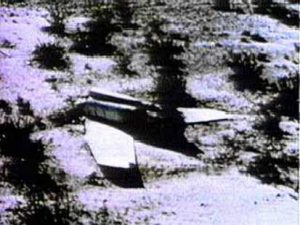 As with any other milestone, records such as Mach 2 flying are just meant to be broken. Mach 3 was the new challenge, and the breaking of this record would come even quicker than the last one had. On September 27, 1956, Milburn G. Apt, flying in the Bell X-2. The plane, which had been nicknamed Starbuster was an X-plane research aircraft built to investigate flight characteristics in the Mach 2–3 range. Apt was a Unites States test pilot, and his specialty was high speeds. He was shooting for and attained the record breaking speed of Mach 3.196 on that fateful September day, but did not live to receive the praise for his accomplishments. The subsequent loss of control of the plane from inertia coupling led to the breakup of the aircraft and Captain Apt’s death.
As with any other milestone, records such as Mach 2 flying are just meant to be broken. Mach 3 was the new challenge, and the breaking of this record would come even quicker than the last one had. On September 27, 1956, Milburn G. Apt, flying in the Bell X-2. The plane, which had been nicknamed Starbuster was an X-plane research aircraft built to investigate flight characteristics in the Mach 2–3 range. Apt was a Unites States test pilot, and his specialty was high speeds. He was shooting for and attained the record breaking speed of Mach 3.196 on that fateful September day, but did not live to receive the praise for his accomplishments. The subsequent loss of control of the plane from inertia coupling led to the breakup of the aircraft and Captain Apt’s death.
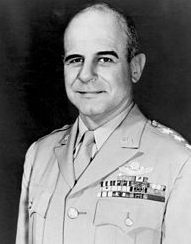 Most of us think very little about piloting a plane. We leave that to the professionals, but how did they get to be professionals? How did they learn all the techniques that they now use every day? Of course, that is a story that is far to long to write here, but suffice it to say that there was a lot of trial and error, a lot of visionaries, and a lot of test pilots who were willing to lay it on the line for progress. Test pilots suffered everything from failure to death in their quest for victory. Eventually they would go on to pave the way for so much innovation, that today, air travel is a commonplace thing, available to almost everyone.
Most of us think very little about piloting a plane. We leave that to the professionals, but how did they get to be professionals? How did they learn all the techniques that they now use every day? Of course, that is a story that is far to long to write here, but suffice it to say that there was a lot of trial and error, a lot of visionaries, and a lot of test pilots who were willing to lay it on the line for progress. Test pilots suffered everything from failure to death in their quest for victory. Eventually they would go on to pave the way for so much innovation, that today, air travel is a commonplace thing, available to almost everyone.
One such innovator, was Jimmy Doolittle. Prior to 1929, planes either had to be rerouted, or not fly in bad weather or limited visibility, but Doolittle was sure that there was a way to fly blind…and land safely. Now he just had to prove it. Until 1929, the only way to fly or land was by sight…known as VFR (Visual Flight Rules). These days pilots know that even if they can’t see, they can still fly safely using the instruments…known as IFR (Instrument Flight Rules).
I’m sure that someone had the idea in their head, that such a thing was possible, with no way to figure it out, but Doolittle was about to make his most important contribution to aeronautical technology…the development of instrument flying. Doolittle realized that true operational freedom in the air could not be achieved unless pilots developed the ability to control and navigate aircraft in flight, from takeoff to landing, regardless of the range of vision from the cockpit. It was an amazing unheard of idea. Doolittle believed that a pilot could be trained to use instruments to fly through fog, clouds, precipitation of all forms, darkness, or any other type of poor visibility. He also believed that the plane could be landed safely even if the pilot’s motion sense was impared. At that time, the ability to control aircraft was partly about getting beyond the motion sense capability of the pilot. You see, sometimes pilots could become seriously disoriented without the visual cues from outside the cockpit. 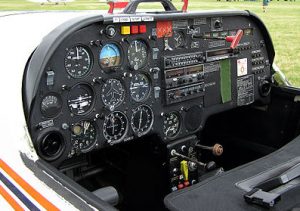
On this day, September 25, 1929, Doolittle would prove his theory, that if a pilot would “trust his instruments” and not his senses, he could safely take off, fly, and land, even if he could not see. Flying blind became a reality when Doolittle took off from and returned to Mitchel Field that September day. He had assisted in the development of fog flying equipment, helped develop, and was then the first to test, the now universally used artificial horizon and directional gyroscope. Of course, the flight made big news and Doolittle was given the Harmon Trophy for conducting the experiment.

